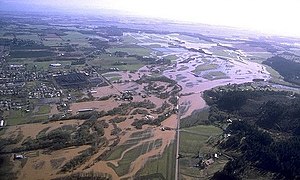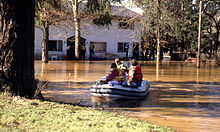

The Willamette Valley flood of 1996 was part of a larger series of floods in the Pacific Northwest of the United States which took place between late January and mid-February 1996. It was Oregon's largest flood event in terms of fatalities and monetary damage during the 1990s. The floods spread beyond Oregon's Willamette Valley, extending west to the Oregon Coast and east toward the Cascade Mountains. Significant flood damage also impacted the American states of Washington, Idaho (particularly the north of the state) and California. The floods were directly responsible for eight deaths in Oregon, as well as over US$500 million in property damage throughout the Pacific Northwest. Three thousand residents were displaced from their homes.
Causes
An unusual confluence of weather events made the floods particularly severe. The winter preceding the floods had produced abnormally high rainfall and relatively low snowfall. The heavy rains saturated ground soil and raised river levels throughout January 1996. In late January, a heavy snowstorm padded snow packs throughout the region. This was followed by a deep freeze that lasted for six to ten days. The new layer of snow was quickly melted by a warm subtropical jetstream which arrived on February 6. The jetstream brought along further rains. The combination of the additional rain, the saturated ground, and the melting snow packs engorged dozens of streams and tributaries, which in turn flooded into the region's major rivers.
Impacts
| This section needs expansion. You can help by adding to it. (June 2015) |


The Willamette River, which flows through downtown Portland, crested at 28.6 feet (8.7 m), some 10.6 feet (3.2 m) above flood stage. The river came within inches of flowing over its seawall and flooding a large portion of Portland's downtown Tom McCall Waterfront Park. A major sandbagging effort involving civilians as well as the Oregon National Guard was launched throughout downtown Portland and was maintained until the floodwaters began to recede on February 9. At least five rivers in Oregon crested at all-time highs during the floods.
The downtown areas of Oregon City and Tillamook suffered particularly heavy damage from the floods, and both were submerged for several days. Several houses in SW Portland were also damaged by the heavy rainfall and a landslide caused one stretch of SW Fairmount Boulevard to be closed for several weeks.
References
- (Colle & Mass 1999, p. 595).
- ^ (Taylor 1996).
- Taylor, George H. (1996). "The Great Flood of 1996". Oregon State University. Archived from the original on 2007-03-04. Retrieved April 3, 2006.
- Colle, Brian A.; Mass, Clifford F. (1999), "The 5–9 February 1996 Flooding Event over the Pacific Northwest: Sensitivity Studies and Evaluation of the MM5 Precipitation Forecasts", Monthly Weather Review, 128 (3): 593–617, Bibcode:2000MWRv..128..593C, doi:10.1175/1520-0493(2000)128<0593:tffeot>2.0.co;2
- "'Things are looking up,' but Northwest flooding problems linger". CNN. Retrieved April 3, 2006.
- "High water invades downtown Portland". CNN. Retrieved April 3, 2006.
External links
- "The Flood of 1996" (PDF). US Army Corps of Engineers - Portland District. Archived from the original (PDF) on January 16, 2009. Retrieved June 15, 2015.
- "The Willamette Valley Flood of 1996". Synopsis and photos. Retrieved April 3, 2006.
- Willingham, William F. "Willamette Valley flood of 1996". The Oregon Encyclopedia.